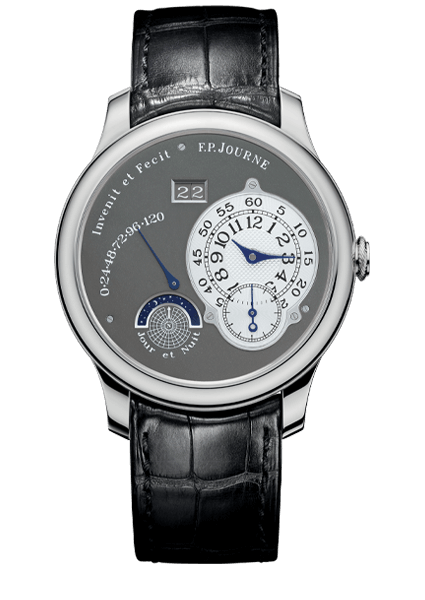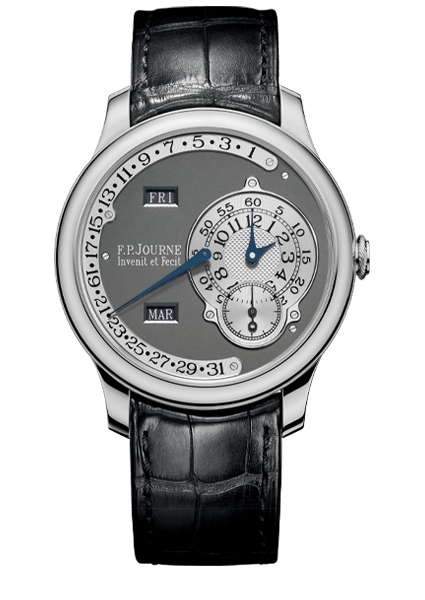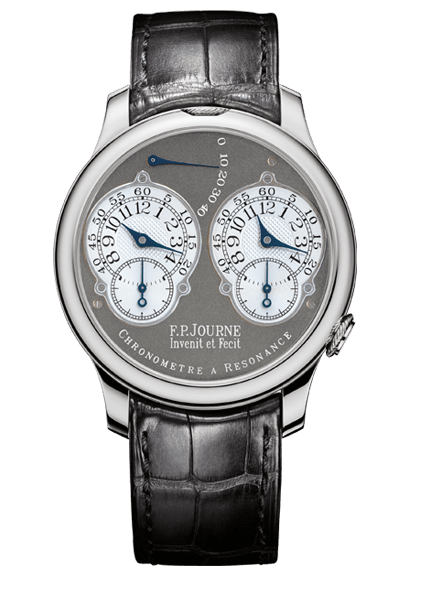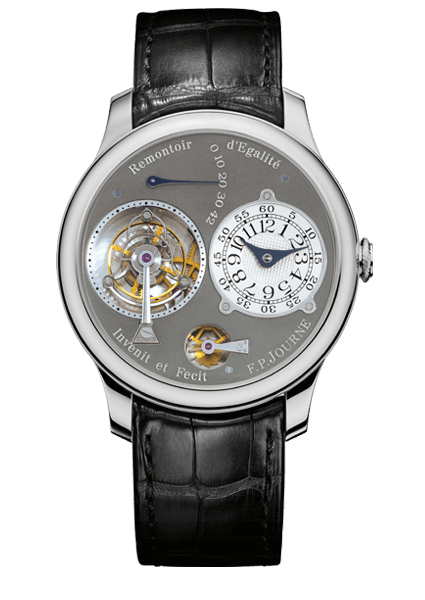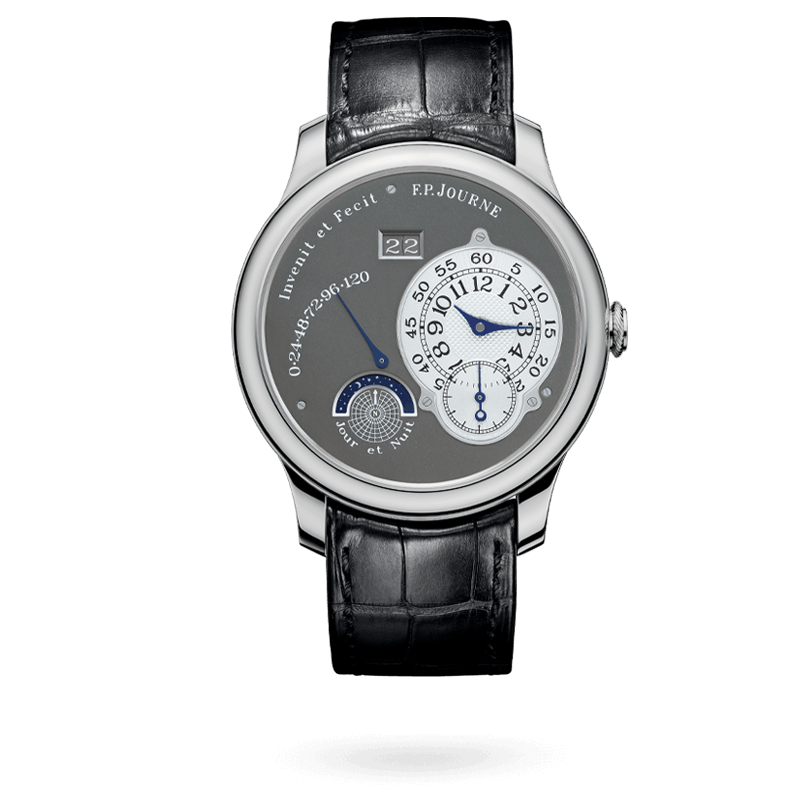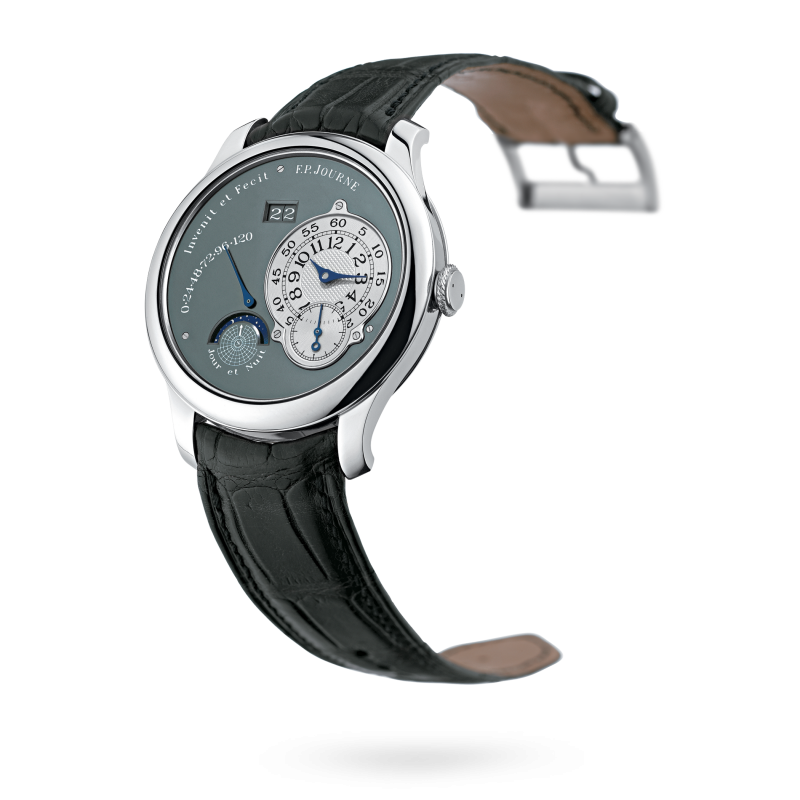CALIBRE 1300 https://www.fpjourne.com/en/collection/ruthenium-collection/octa-journuit FP Journe https://www.fpjourne.com/en FP Journe
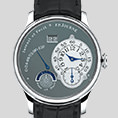
Diameter: 40 mm
Overall height: 10.6 mm
Dial: Ruthenium on Gold and whitened guilloché Silver
Hands: blued Steel
Technical Specifications
Off-center hours and minutes.
Small seconds at 4.30 p.m.
Big date.
Power reserve.
Day Night.
- Overall diameter of mvt : 30.80 mm
- Casing-up diameter of mvt : 30.40 mm
- Overall height of mvt : 5.70 mm
- Height of winding system : 3.00 mm
- Diameter of stem thread : S0.90 mm
In-line escapement, 15 teeth.
Balance with 4 linear weights.
Flat Anachron microflamed spring.
Mobile stud holder.
Free sprung balance.
Nivatronic laser welded to the collet.
Pinned GE stud.
3 positions crown.
Sliping mainspring.
Off-center winding rotor.
274 anti clockwise / 24 hours.
Bi-directionnal automatic winding.
Instant jump calendar.
Setting the date clockwise, in position 2 of the crown and day-night anti clockwise.
Time setting in position 3 of the crown.
21600 VPH, 3 Hz
- Inertia : 10.10 mgcm2
- Angle of lift : 52°
- 0h dial up : 280°
- 120h dial up : 220°
160±12 hours
High grade.
Circular stripes on the bridges.
Baseplate partly circular grained.
Polished screw heads with chamfered slots.
Pegs with polished rounded ends.
Steelworks with polished chamfers and stright graining.
Off-center hours and minutes.
Small seconds at 4.30 p.m.
Big date.
Power reserve.
Day Night.
- Overall diameter of mvt : 30.80 mm
- Casing-up diameter of mvt : 30.40 mm
- Overall height of mvt : 5.70 mm
- Height of winding system : 3.00 mm
- Diameter of stem thread : S0.90 mm
In-line escapement, 15 teeth.
Balance with 4 linear weights.
Flat Anachron microflamed spring.
Mobile stud holder.
Free sprung balance.
Nivatronic laser welded to the collet.
Pinned GE stud.
3 positions crown.
Sliping mainspring.
Off-center winding rotor.
274 anti clockwise / 24 hours.
Bi-directionnal automatic winding.
Instant jump calendar.
Setting the date clockwise, in position 2 of the crown and day-night anti clockwise.
Time setting in position 3 of the crown.
21600 VPH, 3 Hz
- Inertia : 10.10 mgcm2
- Angle of lift : 52°
- 0h dial up : 280°
- 120h dial up : 220°
160±12 hours
High grade.
Circular stripes on the bridges.
Baseplate partly circular grained.
Polished screw heads with chamfered slots.
Pegs with polished rounded ends.
Steelworks with polished chamfers and stright graining.
Technical description
Technical description
Diameter: 40 mm
Overall height: 10.6 mm
Dial: Ruthenium on Gold and whitened guilloché Silver
Hands: blued Steel

Diameter: 40 mm
Overall height: 10.6 mm
Dial: Ruthenium on Gold and whitened guilloché Silver
Hands: blued Steel
Technical Specifications
Off-center hours and minutes.
Small seconds at 4.30 p.m.
Big date.
Power reserve.
Day Night.
- Overall diameter of mvt : 30.80 mm
- Casing-up diameter of mvt : 30.40 mm
- Overall height of mvt : 5.70 mm
- Height of winding system : 3.00 mm
- Diameter of stem thread : S0.90 mm
In-line escapement, 15 teeth.
Balance with 4 linear weights.
Flat Anachron microflamed spring.
Mobile stud holder.
Free sprung balance.
Nivatronic laser welded to the collet.
Pinned GE stud.
3 positions crown.
Sliping mainspring.
Off-center winding rotor.
274 anti clockwise / 24 hours.
Bi-directionnal automatic winding.
Instant jump calendar.
Setting the date clockwise, in position 2 of the crown and day-night anti clockwise.
Time setting in position 3 of the crown.
21600 VPH, 3 Hz
- Inertia : 10.10 mgcm2
- Angle of lift : 52°
- 0h dial up : 280°
- 120h dial up : 220°
160±12 hours
High grade.
Circular stripes on the bridges.
Baseplate partly circular grained.
Polished screw heads with chamfered slots.
Pegs with polished rounded ends.
Steelworks with polished chamfers and stright graining.
Off-center hours and minutes.
Small seconds at 4.30 p.m.
Big date.
Power reserve.
Day Night.
- Overall diameter of mvt : 30.80 mm
- Casing-up diameter of mvt : 30.40 mm
- Overall height of mvt : 5.70 mm
- Height of winding system : 3.00 mm
- Diameter of stem thread : S0.90 mm
In-line escapement, 15 teeth.
Balance with 4 linear weights.
Flat Anachron microflamed spring.
Mobile stud holder.
Free sprung balance.
Nivatronic laser welded to the collet.
Pinned GE stud.
3 positions crown.
Sliping mainspring.
Off-center winding rotor.
274 anti clockwise / 24 hours.
Bi-directionnal automatic winding.
Instant jump calendar.
Setting the date clockwise, in position 2 of the crown and day-night anti clockwise.
Time setting in position 3 of the crown.
21600 VPH, 3 Hz
- Inertia : 10.10 mgcm2
- Angle of lift : 52°
- 0h dial up : 280°
- 120h dial up : 220°
160±12 hours
High grade.
Circular stripes on the bridges.
Baseplate partly circular grained.
Polished screw heads with chamfered slots.
Pegs with polished rounded ends.
Steelworks with polished chamfers and stright graining.
Technical description
Technical description
About
Limited Series Ruthenium, numbered 1 to 99
Case in Platinum, diameter 40 mm
Technical Specifications
Off-center hours and minutes.
Small seconds at 4.30 p.m.
Big date.
Power reserve.
Day Night.
- Overall diameter of mvt : 30.80 mm
- Casing-up diameter of mvt : 30.40 mm
- Overall height of mvt : 5.70 mm
- Height of winding system : 3.00 mm
- Diameter of stem thread : S0.90 mm
In-line escapement, 15 teeth.
Balance with 4 linear weights.
Flat Anachron microflamed spring.
Mobile stud holder.
Free sprung balance.
Nivatronic laser welded to the collet.
Pinned GE stud.
3 positions crown.
Sliping mainspring.
Off-center winding rotor.
274 anti clockwise / 24 hours.
Bi-directionnal automatic winding.
Instant jump calendar.
Setting the date clockwise, in position 2 of the crown and day-night anti clockwise.
Time setting in position 3 of the crown.
21600 VPH, 3 Hz
- Inertia : 10.10 mgcm2
- Angle of lift : 52°
- 0h dial up : 280°
- 120h dial up : 220°
160±12 hours
High grade.
Circular stripes on the bridges.
Baseplate partly circular grained.
Polished screw heads with chamfered slots.
Pegs with polished rounded ends.
Steelworks with polished chamfers and stright graining.
Off-center hours and minutes.
Small seconds at 4.30 p.m.
Big date.
Power reserve.
Day Night.
- Overall diameter of mvt : 30.80 mm
- Casing-up diameter of mvt : 30.40 mm
- Overall height of mvt : 5.70 mm
- Height of winding system : 3.00 mm
- Diameter of stem thread : S0.90 mm
In-line escapement, 15 teeth.
Balance with 4 linear weights.
Flat Anachron microflamed spring.
Mobile stud holder.
Free sprung balance.
Nivatronic laser welded to the collet.
Pinned GE stud.
3 positions crown.
Sliping mainspring.
Off-center winding rotor.
274 anti clockwise / 24 hours.
Bi-directionnal automatic winding.
Instant jump calendar.
Setting the date clockwise, in position 2 of the crown and day-night anti clockwise.
Time setting in position 3 of the crown.
21600 VPH, 3 Hz
- Inertia : 10.10 mgcm2
- Angle of lift : 52°
- 0h dial up : 280°
- 120h dial up : 220°
160±12 hours
High grade.
Circular stripes on the bridges.
Baseplate partly circular grained.
Polished screw heads with chamfered slots.
Pegs with polished rounded ends.
Steelworks with polished chamfers and stright graining.
Technical description
Technical description
-
About
This watch was produced between 2002 and 2005
Limited Series Ruthenium, numbered 1 to 99
Case in Platinum, diameter 40 mm
-
Technical description
Technical Specifications
Indications :Off-center hours and minutes.
Small seconds at 4.30 p.m.
Big date.
Power reserve.
Day Night.Dimensions :- Overall diameter of mvt : 30.80 mm
- Casing-up diameter of mvt : 30.40 mm
- Overall height of mvt : 5.70 mm
- Height of winding system : 3.00 mm
- Diameter of stem thread : S0.90 mm
Caracteristics :In-line escapement, 15 teeth.
Balance with 4 linear weights.
Flat Anachron microflamed spring.
Mobile stud holder.
Free sprung balance.
Nivatronic laser welded to the collet.
Pinned GE stud.
3 positions crown.
Sliping mainspring.
Off-center winding rotor.Auto winding :274 anti clockwise / 24 hours.
Main features :Bi-directionnal automatic winding.
Instant jump calendar.
Setting the date clockwise, in position 2 of the crown and day-night anti clockwise.
Time setting in position 3 of the crown.Frequency :21600 VPH, 3 Hz
Balance :- Inertia : 10.10 mgcm2
- Angle of lift : 52°
Amplitude :- 0h dial up : 280°
- 120h dial up : 220°
Power reserve :160±12 hours
Finishing :High grade.
Circular stripes on the bridges.
Baseplate partly circular grained.
Polished screw heads with chamfered slots.
Pegs with polished rounded ends.
Steelworks with polished chamfers and stright graining.Indications :Off-center hours and minutes.
Small seconds at 4.30 p.m.
Big date.
Power reserve.
Day Night.Dimensions :- Overall diameter of mvt : 30.80 mm
- Casing-up diameter of mvt : 30.40 mm
- Overall height of mvt : 5.70 mm
- Height of winding system : 3.00 mm
- Diameter of stem thread : S0.90 mm
Caracteristics :In-line escapement, 15 teeth.
Balance with 4 linear weights.
Flat Anachron microflamed spring.
Mobile stud holder.
Free sprung balance.
Nivatronic laser welded to the collet.
Pinned GE stud.
3 positions crown.
Sliping mainspring.
Off-center winding rotor.Auto winding :274 anti clockwise / 24 hours.
Main features :Bi-directionnal automatic winding.
Instant jump calendar.
Setting the date clockwise, in position 2 of the crown and day-night anti clockwise.
Time setting in position 3 of the crown.Frequency :21600 VPH, 3 Hz
Balance :- Inertia : 10.10 mgcm2
- Angle of lift : 52°
Amplitude :- 0h dial up : 280°
- 120h dial up : 220°
Power reserve :160±12 hours
Finishing :High grade.
Circular stripes on the bridges.
Baseplate partly circular grained.
Polished screw heads with chamfered slots.
Pegs with polished rounded ends.
Steelworks with polished chamfers and stright graining.
At the heart of the movementAt the heart of the movementTechnical description
Technical description
Technical Specifications
Off-center hours and minutes.
Small seconds at 4.30 p.m.
Big date.
Power reserve.
Day Night.
- Overall diameter of mvt : 30.80 mm
- Casing-up diameter of mvt : 30.40 mm
- Overall height of mvt : 5.70 mm
- Height of winding system : 3.00 mm
- Diameter of stem thread : S0.90 mm
In-line escapement, 15 teeth.
Balance with 4 linear weights.
Flat Anachron microflamed spring.
Mobile stud holder.
Free sprung balance.
Nivatronic laser welded to the collet.
Pinned GE stud.
3 positions crown.
Sliping mainspring.
Off-center winding rotor.
274 anti clockwise / 24 hours.
Bi-directionnal automatic winding.
Instant jump calendar.
Setting the date clockwise, in position 2 of the crown and day-night anti clockwise.
Time setting in position 3 of the crown.
21600 VPH, 3 Hz
- Inertia : 10.10 mgcm2
- Angle of lift : 52°
- 0h dial up : 280°
- 120h dial up : 220°
160±12 hours
High grade.
Circular stripes on the bridges.
Baseplate partly circular grained.
Polished screw heads with chamfered slots.
Pegs with polished rounded ends.
Steelworks with polished chamfers and stright graining.
Off-center hours and minutes.
Small seconds at 4.30 p.m.
Big date.
Power reserve.
Day Night.
- Overall diameter of mvt : 30.80 mm
- Casing-up diameter of mvt : 30.40 mm
- Overall height of mvt : 5.70 mm
- Height of winding system : 3.00 mm
- Diameter of stem thread : S0.90 mm
In-line escapement, 15 teeth.
Balance with 4 linear weights.
Flat Anachron microflamed spring.
Mobile stud holder.
Free sprung balance.
Nivatronic laser welded to the collet.
Pinned GE stud.
3 positions crown.
Sliping mainspring.
Off-center winding rotor.
274 anti clockwise / 24 hours.
Bi-directionnal automatic winding.
Instant jump calendar.
Setting the date clockwise, in position 2 of the crown and day-night anti clockwise.
Time setting in position 3 of the crown.
21600 VPH, 3 Hz
- Inertia : 10.10 mgcm2
- Angle of lift : 52°
- 0h dial up : 280°
- 120h dial up : 220°
160±12 hours
High grade.
Circular stripes on the bridges.
Baseplate partly circular grained.
Polished screw heads with chamfered slots.
Pegs with polished rounded ends.
Steelworks with polished chamfers and stright graining.
